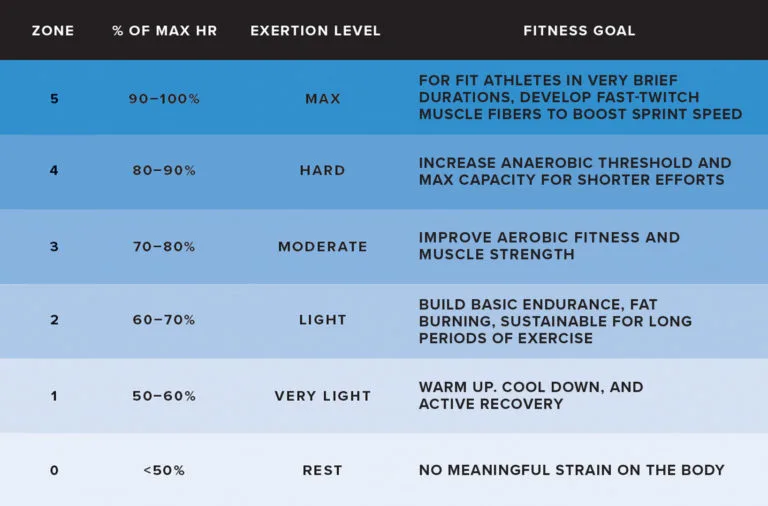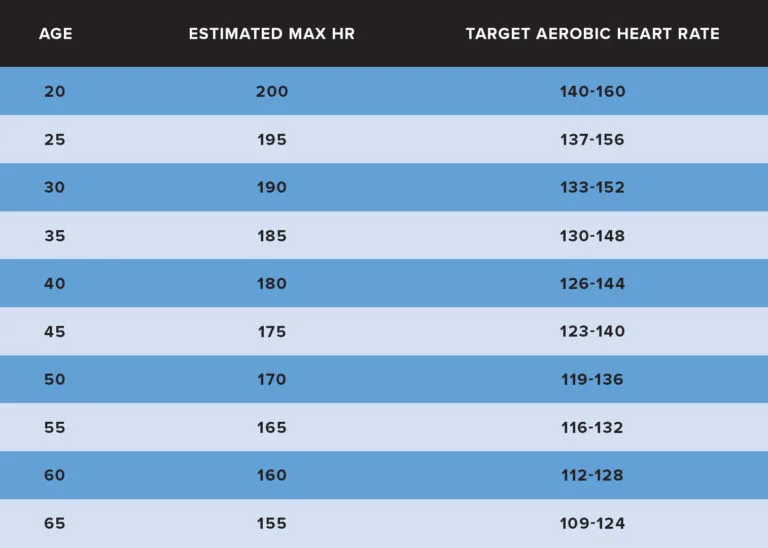Topics
- Article
- Heart Rate
- Training & Exercise
What is the Aerobic Heart Rate Zone and How Do You Target it?

Learn how to take advantage of your aerobic heart rate zone during workouts.
When you work out, how do you tell if you’re getting the most out of a workout? Are you pushing too hard or not hard enough? Targeting your aerobic heart rate zone and exercising at the right intensity can help you maximize the effectiveness of your aerobic workouts and better meet your fitness goals.
What Does Aerobic Heart Rate Zone Mean?
The word aerobic means “needs oxygen,” and oxygen provides a steady stream of energy to the body during aerobic exercises, or cardio. Aerobic exercise burns both fat and carbohydrates (also called glycogen) for energy. It increases your heart rate for a longer period than other forms of activity. Generally, you use your major muscle groups continuously to bring your heart rate into this zone. The aerobic heart rate zone is a heart rate between 70% and 80% of your maximum heart rate (MHR). You reach it while exercising at moderate to vigorous intensity. In this zone your breathing quickens, but you’re not out of breath, and you can still have a conversation with a person running next to you. The aerobic heart rate zone is zone three of the five heart rate zones.

Your individual aerobic heart rate zone is a heart rate between 70% and 80% of your max heart rate.
Exercises in this zone are sustainable for long periods of time, at least 40 minutes. Moderate aerobic activities include brisk walking, swimming and mowing the lawn (with a push mower). At least 150 minutes a week of moderate activity or 75 minutes per week of vigorous aerobic activity is recommended by the Department of Health and Human Services. Ramping up to 300 minutes (five hours) or more of moderate aerobic activity, or 150 minutes (2.5 hours) of vigorous aerobic activity has additional health benefits for most people.
Aerobic Heart Rate Zones by Age Chart
Aerobic heart rate is based on max heart rate for your age, gender and conditioning. A commonly used max heart rate formula is subtracting your age from 220. By this method, the max HR for a 40-year-old is 180 beats per minute (BPM). However, this equation does not consider your specific variables, such as gender, genetics, conditioning, etc.

Individual max heart rate and the aerobic heart rate zone decline as we age.
Other formulas that include more detail (and more math) include the Tanaka formula (208 - 1.7 x age) and the Gulati formula (206 - 0.88 x age, for women only) but these formulas also make broad generalizations and don’t allow for the variables listed above. You can use a heart rate zone calculator or charts like the one here to find your results based on your personal characteristics. Other factors that can affect heart rate include:
- Hydration
- Body temperature
- Emotions
- Physical activity and strain
- Sleep
- Medication
- Menstrual cycle
- Ambient temperature and weather
- Altitude
Learn More: Running Heart Rate Zones
WHOOP uses the heart rate reserve method, which takes into account your max heart rate and resting heart rate over the last 14 recoveries to give you more accurate and personalized HR zones, so as you make progress your HR zones will reflect that.
You can also manually adjust your HR zones to further personalize your experience.
To adjust Max HR & HR Zones
Tap More > App Settings > Activity Settings > Heart Rate Settings
Benefits of Aerobic Zone Exercises
Aerobic exercise provides numerous benefits including reducing your risk of a heart attack, stroke and type 2 diabetes. Other benefits include:
- Losing weight and helping to keep it off
- Lowering and controlling blood pressure
- Increasing stamina and reducing fatigue during exercise
- Activating the immune systems and warding off viral illnesses, making you less likely to get colds or the flu
- Strengthening your heart
- Boosting mood, easing the lows of depression and reducing tension and anxiety
- Improving sleep
- Managing chronic conditions, reducing pain and increasing function in people with arthritis, and enhancing the quality of life in people who have had cancer
- Boosting HDL “good” cholesterol and lowering LDL “bad” cholesterol
Examples of Aerobic Workouts
Moderate aerobic workouts do not have to include jogging or walking mile after mile on hard pavement, or swimming laps in a pool. Varying types of exercise will help you work different muscle groups, avoid letting your body get used to the strain, and let you find workouts that you personally enjoy.
Moderate Aerobic Workouts
- Hiking
- Cycling
- Dancing (such as aerobic dance classes)
- Rowing machine
- Kayaking and canoeing
- In-line and roller skating
- Cross-country skiing
- Stair climbing and elliptical machine
- Spin class and other stationary bike routines
- Circuit training (weightlifting can be an aerobic activity if your heart rate stays within the aerobic zone)
- Chores such as sweeping, vacuuming and mopping can also provide moderate aerobic exercise
Vigorous Aerobic Workouts
Vigorous aerobic activity occurs when your breath is coming hard and fast and it’s difficult to talk or maintain a conversation with your exercise partner. These workouts consume more oxygen to complete the activity. Examples include:
- Running
- Swimming
- Shoveling snow (use that exercise as a reason to shovel the driveway)
- Jumping rope
- Carrying heavy loads
- Uphill hiking
- Cycling more than 10 mph or uphill
- Step aerobics
- Heavy gardening (think spring gardening with digging, raking leaves, and carrying wheelbarrows of compost)
- Martial arts
- Tennis and other court sports such as handball, squash and racquetball
- Team sports with lots of running or movement like basketball, soccer and hockey
Learn More: How Does Trying a New Type of Workout Impact Your Body?
Aerobic vs Anaerobic Heart Rate Zones
Anaerobic exercise involves short, intense bursts of movement, and burns only carbohydrates for energy. While your body can take in enough oxygen to sustain your activity level during aerobic exercise, anaerobic exercise causes your muscles to need more energy than oxygen can provide. This means your muscles begin breaking down glucose to produce lactic acid. The target heart rate for anaerobic exercise is between 80% and 90% of your max heart rate. These exercises generally target specific muscle groups, such as biceps, triceps, quads, etc. This heart rate zone is useful in non-endurance sports and activities that require power output, such as weightlifting, sprinting and interval running, and high intensity interval training (HIIT). An exercise program or training plan that includes aerobic and anaerobic components can help you gain lean muscle mass and burn fat more quickly than just one or the other.
Measure Your Heart Rate and Know Which Zone You’re In With WHOOP
WHOOP is a heart rate monitor that measures your HR 24/7 and quantifies the strain your body takes on each day, and for specific workouts and activities. When you track your exercise with the app’s Strain Target, you can see your heart rate zones in real time, so you’ll know if you need to hold back or turn it up to get into your target heart rate zone. Each morning, the WHOOP recovery metric (calculated using heart rate variability, resting heart rate, respiratory rate and sleep) lets you know how prepared your body is to take on strain. The Strain Target then gives you exertion-level recommendations based on your recovery, enabling you to workout for the optimal duration and intensity relative to what your body is ready to handle.